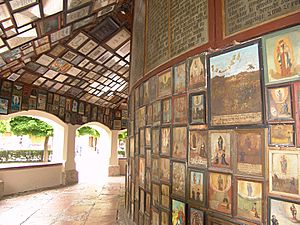Votive offering facts for kids
A votive offering is a special gift that people leave in a holy place, like a temple or a shrine. These gifts are left without the plan to ever take them back or use them again. People make votive offerings for religious reasons, often to ask for help from gods or spirits, or to say thank you for something good that happened.
These kinds of gifts have been part of human societies for a very long time, both in ancient times and today. They are usually given to try and get favor or good luck from powerful beings.
In the study of ancient times, called archaeology, votive offerings are different from hidden collections of valuable items, known as hoards. Even though both might contain similar objects, votive offerings were never meant to be found or used again by the person who left them.

Contents
What Are Votive Offerings?
A votive offering is like a promise or a thank-you gift. The word "votive" comes from a Latin word meaning "vow" or "promise." So, it's a gift made as part of a promise to a god or spirit.
Why Do People Make Votive Offerings?
People make these offerings for many reasons:
- Asking for help: They might ask for good health, a safe journey, success in a battle, or a good harvest.
- Showing thanks: If a prayer was answered or a wish came true, an offering is given to show gratitude.
- Honoring a deity: Sometimes, it's simply a way to show respect and devotion to a god or a saint.
- Marking an event: Offerings can also celebrate important life events, like a birth or a wedding.
Where Are Votive Offerings Found?
Votive offerings can be found in many different places around the world:
- Temples and churches: These are common places for offerings, often placed near altars or statues.
- Natural sites: People have left offerings at special natural spots like springs, caves, sacred trees, or mountain peaks.
- Burial sites: Sometimes, objects are left with the dead as offerings for the afterlife.
What Kinds of Things Are Offered?
The types of gifts vary greatly depending on the culture and the time period. Some common examples include:
- Small statues: Often figures of people, animals, or gods.
- Pottery and vessels: Used for liquids or food, sometimes left empty.
- Weapons and tools: Miniature versions or actual items.
- Jewelry and coins: Valuable items showing dedication.
- Paintings or tablets: Special pictures or carved stones.
- Food and drink: Perishable items, often left for a short time.
- Body parts: Sometimes, models of body parts (like a leg or an eye) are offered, especially when praying for healing.
Votive Offerings in History
Archaeologists, who study ancient civilizations, often find votive offerings when they dig up old sites. These discoveries help us understand what was important to people long ago. They show us what gods people worshipped, what they prayed for, and what their daily lives were like.
For example, in ancient Greece and Rome, people left small statues, pottery, and even miniature tools in temples. In some cultures, people threw valuable items into lakes or rivers as offerings. These findings give us clues about the beliefs and customs of past societies.
Images for kids
-
Part of a female face with inlaid eyes, Ancient Greek Votive offering, 4th century BC, probably by Praxias, set in a niche of a pillar in the sanctuary of Asclepios in Athens, Acropolis Museum, Athens
-
Ancient Greek votive relief, 400 BC. Asclepios is sitting on an omphalos between
-
Stupika which contains Buddhist votive tablets, 8th-century Bali
-
Wonderworking icon of the Theotokos, "The Three-handed" (Trojeručica); the third hand in silver is a votive offering in thanksgiving for a miracle.
See also
 In Spanish: Ofrenda votiva para niños
In Spanish: Ofrenda votiva para niños







